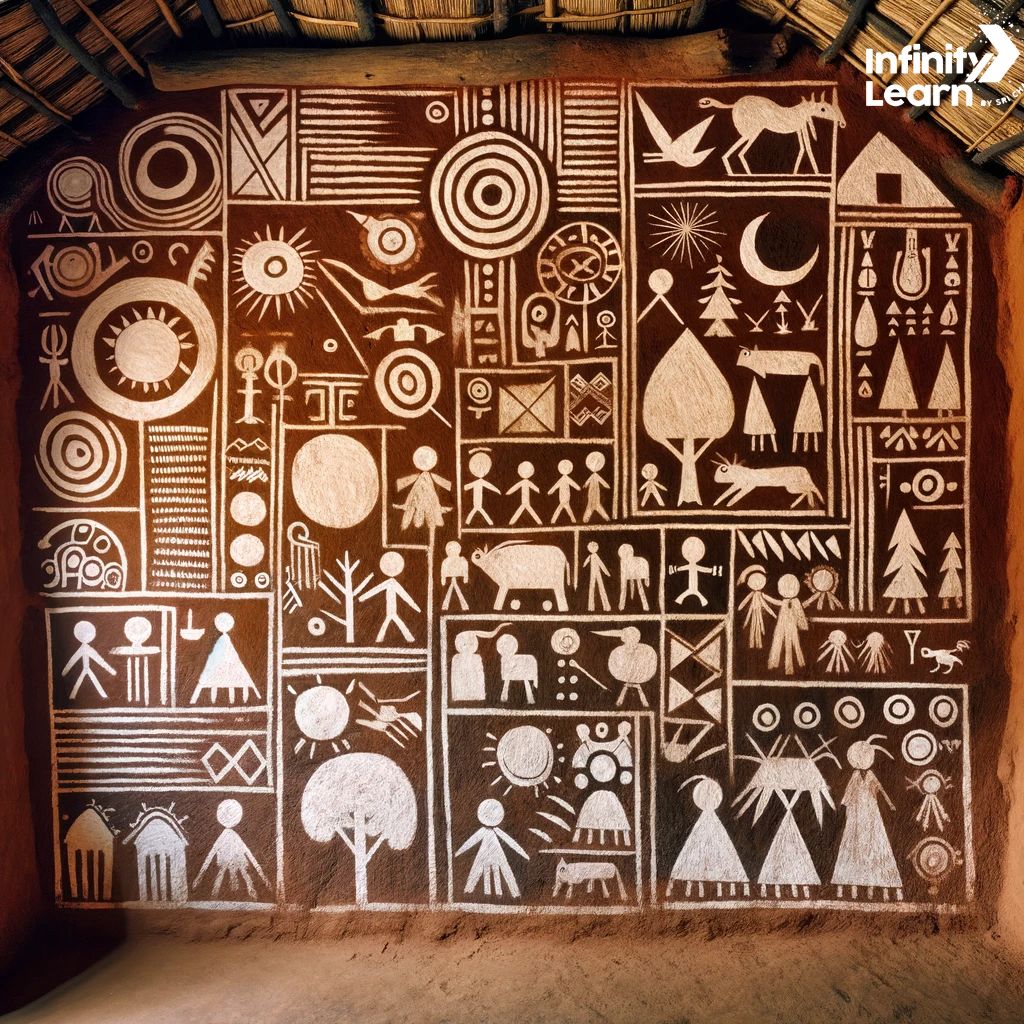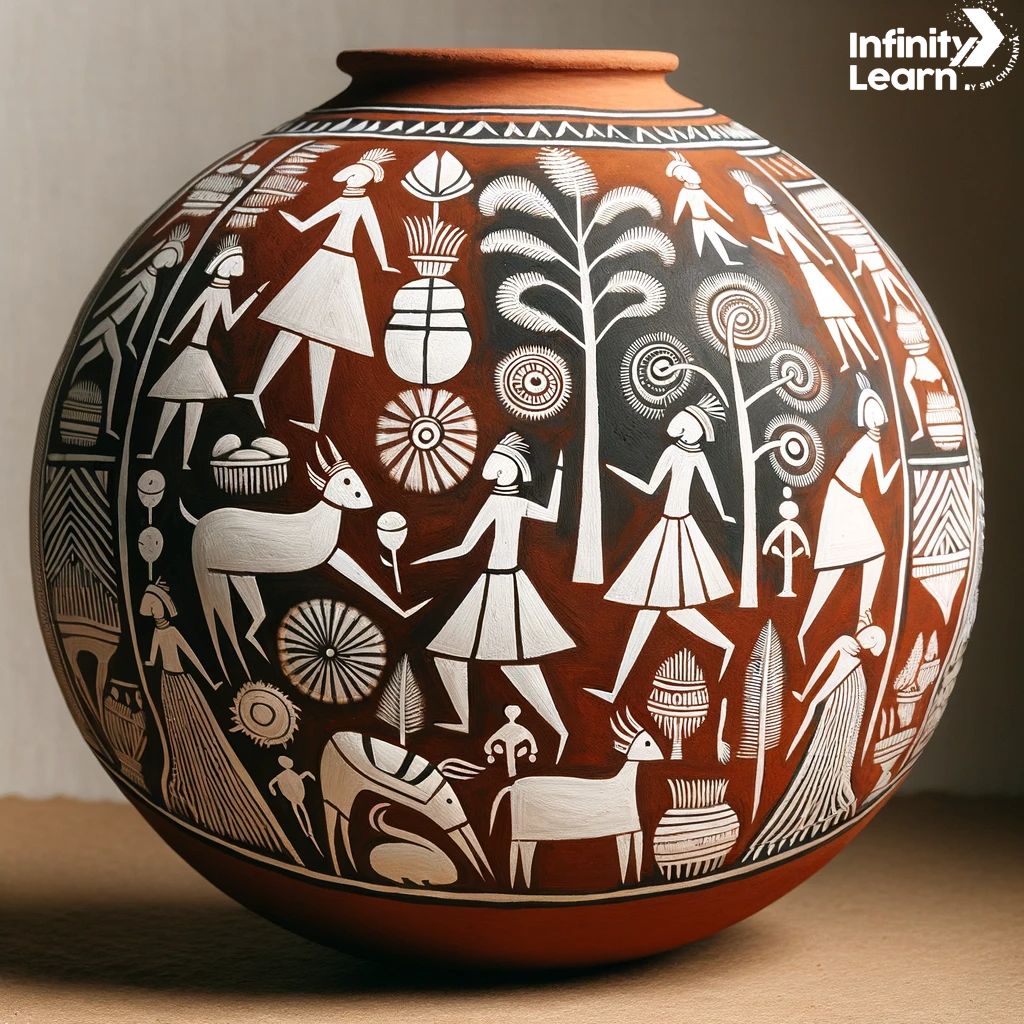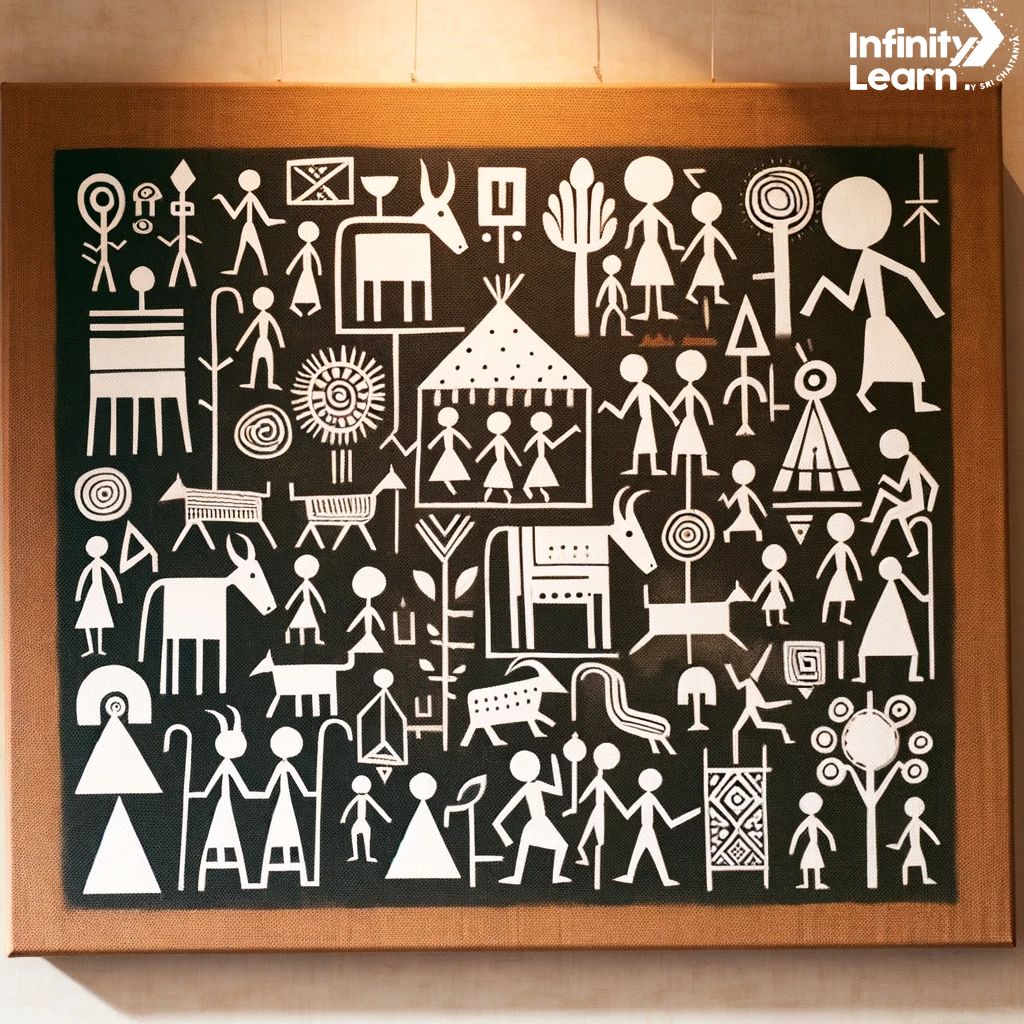Table of Contents
Warli painting is a type of tribal wall art made by the Warli tribe in Maharashtra, India. They use basic shapes like circles, triangles, and squares to show nature, people, animals, and houses. Circles stand for the sun and moon, triangles for mountains and trees, and squares for things people make.
Warli paintings are simple and only use white paint made from rice and water on a red background. They belong to the Warli tribal community’s culture and have been passed down through generations.
Warli Painting History
The history of Warli painting goes way back to around the 10th century AD, with its origins rooted in ancient cave paintings from 2500 to 3000 BCE. Warli art painting is a type of mural art created by the Warli tribe, who live in the North Sahyadri Range in Maharashtra, India. This art is inspired by the tribe’s close connection with nature and the forests.
Here’s a simplified summary of the history of Warli painting:
- Origins: Warli paintings likely started in the 10th century AD or even earlier. Initially, they were painted on the walls of clay huts, similar to ancient cave art.
- Discovery: Warli art painting gained popularity in the late 1970s when an artist named Jivya Soma Mashe began practicing it regularly.
- Preservation: Warli painting is considered a valuable cultural heritage of the tribal community, passed down through generations and gaining recognition worldwide.
- Contemporary Interpretations: In recent years, Warli art painting has evolved to include contemporary themes and styles, such as paintings on canvas and textiles.
- Global Recognition: Warli art painting has become highly appreciated around the world, with talented artists showcasing their skills and preserving their unique tradition.
Today, Warli paintings are made using a mixture of rice paste and water as white paint on a red earthen background. This art has expanded beyond its traditional use and is now seen in various forms like fashion and design.
Evolution of Warli Painting
Warli painting, an ancient art form from the Warli tribe in Maharashtra, India, has gone through significant changes influenced by both the tribe’s culture and outside factors:
- Ancient Beginnings: Warli painting has a history dating back to the 10th century AD, while the Warli tribe itself has been around since 2500 BCE. The art was originally a way for the tribe to express their daily lives and customs.
- Cultural Depictions: At first, these paintings showed the Warli tribe’s strong connection to nature, portraying scenes of village life like farming, hunting, dancing, and elements of nature and tribal gods.
- Materials and Techniques: Traditional Warli paintings were done on the walls of tribal huts using a mixture of cow dung and mud as the canvas and rice paste mixed with water and gum as paint. This method highlighted the tribe’s resourcefulness and their link to the environment.
- Symbols and Style: Warli paintings used shapes like circles, triangles, and squares to symbolize things like the sun, moon, mountains, humans, and animals in a unique Warli style.
- Secrets and Tradition: For centuries, the knowledge of Warli painting was kept within the Warli community, passed down through generations. It wasn’t just art but also a way to tell stories and pass down folklore.
- Modern Recognition: In the 20th century, especially in the 1970s, Warli painting started to gain recognition beyond the tribe, thanks to artists like Jivya Soma Mashe. This led to a revival and change in the art, making it more widely known.
- Contemporary Changes: Today, Warli painting still keeps its traditional themes and techniques but has adapted to modern times. Artists now use materials like canvas and paper, and some even include modern elements and subjects in their work.
Types of Warli Painting
Warli paintings come in different types based on what they show, how they look, and their purpose. Here are some common kinds:
- Traditional Ritual Paintings: These paintings show the daily life, ceremonies, and rituals of the Warli tribe. They often display scenes like dancing, hunting, farming, and worship. These traditional Warli paintings are a way for the tribe to share their culture and beliefs.
- Modern Interpretations: Some paintings are modern takes on Warli art. They use new themes and styles and might use different colors and materials like canvas or textiles to create unique art.
- Warli on Canvas: Warli paintings on canvas are quite popular nowadays. They’re made using acrylic or oil paints on canvas and often show nature, animals, and people.
- Warli on Textiles: Warli art is also used to make beautiful clothing like sarees, dupattas, and kurtis. These textiles often have intricate Warli designs and add a touch of traditional elegance to modern fashion.
| Culture of Bihar | Odisha Culture |
| Culture of Manipur | Culture of Assam |
| Culture of Rajasthan | Culture of Kerala |
| Culture of Telangana | |
Categories of Warli Painting
Features of Warli Paintings
Warli painting designs are a special type of tribal art that comes from Maharashtra, India. Warli paintings are known for their simple and straight-line style. Here are the salient features about Warli paintings:
- Basic Shapes: In Warli paintings, they use simple shapes like circles, triangles, and squares to show things from nature and everyday life.
- Daily Life: These paintings show parts of everyday life like dancing, playing, and doing rituals. This gives us a peek into how the Warli people live together and enjoy their lives.
- Symbols and Culture: The patterns and figures in Warli art stand for harmony, unity, and how close the Warli tribe is. This shows their culture and how they all stick together.
- Where it Comes From: Warli art started in Maharashtra and is tied to the Warli tribe’s culture, beliefs, and traditions. It shows how they care about nature and animals.
- How They Do It: At first, they painted Warli art on walls using a white mix made from rice. But now, they also paint on things like cloth, mud pots, and dried bamboo.
Together, all these things make Warli paintings unique and culturally important form of tribal art. They show us the daily life, culture, and traditions of the Warli art.
Warli Painting Technique
The basic technique of Warli painting involves using straightforward and symbolic elements to show different parts of everyday life and nature. These paintings use basic shapes like circles, triangles, and squares. Circles usually stand for the sun and the moon, while triangles and squares are used for mountains, trees, and people. These artworks are flat and don’t show depth or accurate proportions. They often have repeating and meaningful patterns and symbols. Warli art is traditionally made with white paint from a mix of rice flour and water, applied on a dark surface. These paintings can be done on walls, fabric, paper, clay pots, and other items, but they don’t depict gods or stories from myths. The technique is easy to learn, which makes it a simple form of tribal art that beginners can enjoy.
Process of Warli Painting
- Prepare the Surface: Traditionally, Warli painting is done on walls prepared with a base of cow dung and mud, giving it a reddish-brown color. Nowadays, it can also be done on paper or canvas.
- Make the Paint: The paint is usually a simple mixture of rice paste (rice powder mixed with water) and a natural gum for binding. This creates a white paint that is used for drawing.
- Create the Brush: A bamboo stick chewed at the end is commonly used as a brush. This gives a fine point for detailed work.
- Draw Basic Shapes: Warli art primarily uses geometric shapes like circles, triangles, and squares. Circles represent celestial bodies, triangles are mountains or trees, and squares signify land or sacred enclosures.
- Depict Everyday Life: Draw simple stick figures to represent people and animals. These figures are usually engaged in everyday activities like dancing, farming, or hunting.
- Rhythmic Patterns: Arrange the figures in rhythmic patterns to create a sense of movement and community.
Warli Painting Designs
Warli painting designs is known for its simplicity and beauty. It’s features represent the culture and traditions of the Warli tribe. Here are some important design elements often seen in Warli paintings:
- Basic Shapes: Warli art uses simple shapes like circles, triangles, and squares. Circles can stand for the sun and moon, triangles represent mountains or trees, and squares symbolize land or sacred areas.
- People: In Warli paintings, people are shown as two triangles joined at the tip. They usually hold hands and dance in a circle, depicting the Tarpa dance, a traditional Warli tribal dance.
- Animals: You’ll also find animals like horses, birds, tigers, and cattle in Warli paintings. These animal depictions are simple, in keeping with the overall style, and often show them doing daily activities with humans.
- Daily Life Scenes: Everyday activities like farming, hunting, cooking, and fishing are common themes. These scenes show how closely connected the Warli people are to their environment.
- Nature: Trees, flowers, and other natural elements are frequently featured, reflecting the Warli’s deep respect for nature.
- Festivals: Social events and festivals, especially those related to agriculture, are often shown. Dancing and music scenes, especially around the Tarpa dance, symbolize community and harmony.
- Myths and Religion: Some designs may include gods, goddesses, and stories from mythology, although these are less common.
- Cosmic Elements: Elements like the sun, moon, and stars are incorporated, symbolizing various aspects of life and the universe.
FAQs on Warli Painting
How old is Warli painting?
Warli painting dates back to around 2500 BCE, making it thousands of years old. It originates from the Warli tribe in Maharashtra, India.
What colour is Warli art?
Traditional Warli art primarily uses white color on a red or dark background. The white is made from a mixture of rice paste and water.
Which state is famous for Warli painting?
Maharashtra, in Western India, is famous for Warli painting, a unique art form created by the indigenous Warli tribe.
What is the concept of Warli painting?
Warli painting captures daily life and social events of the Warli tribe using simple geometric shapes and figures, emphasizing harmony with nature.
How to make Warli painting?
To create Warli painting, prepare a background, make white rice paste paint, and use simple geometric shapes to depict life and nature scenes.
What is Warli painting?
Warli painting is a tribal art form from Maharashtra, characterized by simple geometric shapes and depicting the Warli tribe's daily life and rituals.
Which colour is used for Warli painting?
White is the primary color used in Warli painting, created from rice paste. It is used for drawing on a contrasting dark background.
How to do Warli painting on pots?
To do Warli painting on pots, first paint the pot in a dark color. Once dry, use white paint to draw Warli figures and designs on the pot.












